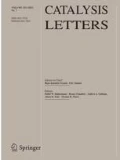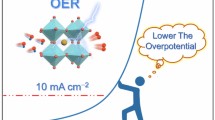Abstract
Research on H2 production has recently been directed to the development of cost-efficient and robust heterogeneous catalysts for hydrogen evolution reaction (HER). Given the promising catalytic activities of several cobalt-based systems and the robustness of Prussian blue analogues in harsh catalytic processes including water oxidation, a Co–Co Prussian blue analogue was investigated as a HER catalyst for the first time. Co–Co Prussian Blue modified fluorine doped tin oxide (FTO) electrode demonstrated a significant HER activity with an onset overpotential of 257 mV, a Tafel slope of 80 mV dec−1, and a turnover frequency of 0.090 s−1 at an overpotential of 250 mV. Comparative XPS, Infrared, and XRD studies performed on pristine and post-catalytic electrodes confirm the stability of the catalyst.
Graphical Abstract







Similar content being viewed by others
References
Goldemberg J (1995) Energy needs in developing countries and sustainability. Science 269:1058–1059. https://doi.org/10.1126/science.269.5227.1058
Hoel M, Kverndokk S (1996) Depletion of fossil fuels and the impacts of global warming. Resour Energy Econ 18:115–136. https://doi.org/10.1016/0928-7655(96)00005-X
Höök M, Tang X (2013) Depletion of fossil fuels and anthropogenic climate change: a review. Energy Policy 52:797–809. https://doi.org/10.1016/j.enpol.2012.10.046
Schlapbach L, Züttel A (2001) Hydrogen-storage materials for mobile applications. Nature 414:353–358. https://doi.org/10.1038/35104634
Durbin DJ, Malardier-Jugroot C (2013) Review of hydrogen storage techniques for on board vehicle applications. Int J Hydrog Energy 38:14595–14617. https://doi.org/10.1016/j.ijhydene.2013.07.058
Paggiaro R, Bénard P, Polifke W (2010) Cryo-adsorptive hydrogen storage on activated carbon I: thermodynamic analysis of adsorption vessels and comparison with liquid and compressed gas hydrogen storage. Int J Hydrog Energy 35:638–647. https://doi.org/10.1016/j.ijhydene.2009.10.108
Weinberger B, Lamari FD (2009) High pressure cryo-storage of hydrogen by adsorption at 77K and up to 50 MPa. Int J Hydrog Energy 34:3058–3064. https://doi.org/10.1016/j.ijhydene.2009.01.093
Ahluwalia RK, Hua TQ, Peng J-K, Lasher S, McKenney K, Sinha J et al (2010) Technical assessment of cryo-compressed hydrogen storage tank systems for automotive applications. Int J Hydrog Energy 35:4171–4184. https://doi.org/10.1016/j.ijhydene.2010.02.074
Wang L, Zheng C, Li R, Chen B, Wei Z (2014) Numerical analysis of temperature rise within 70 MPa composite hydrogen vehicle cylinder during fast refueling. J Cent South Univ 21:2772–2778. https://doi.org/10.1007/s11771-014-2240-9
Khan MTI, Monde M, Setoguchi T (2009) Hydrogen gas filling into an actual tank at high pressure and optimization of its thermal characteristics. J Therm Sci 18:235–240. https://doi.org/10.1007/s11630-009-0235-x
Koper MTM, Bouwman E (2010) Electrochemical hydrogen production: bridging homogeneous and heterogeneous catalysis. Angew Chem Int Ed 49:3723–3725. https://doi.org/10.1002/anie.201000629
Parsons R (1958) The rate of electrolytic hydrogen evolution and the heat of adsorption of hydrogen. Trans Faraday Soc 54:1053–1063. https://doi.org/10.1039/tf9585401053
Burke LD, Naser NS, Ahern BM (2007) Use of iridium oxide films as hydrogen gas evolution cathodes in aqueous media. J Solid State Electrochem 11:655–666. https://doi.org/10.1007/s10008-006-0221-0
Durst J, Simon C, Hasche F, Gasteiger HA (2014) Hydrogen oxidation and evolution reaction kinetics on carbon supported Pt, Ir, Rh, and Pd electrocatalysts in acidic media. J Electrochem Soc 162:F190–F203. https://doi.org/10.1149/2.0981501jes
Sheng W, Gasteiger HA, Shao-Horn Y (2010) Hydrogen oxidation and evolution reaction kinetics on platinum: acid vs alkaline electrolytes. J Electrochem Soc 157:B1529–B1536. https://doi.org/10.1149/1.3483106
Rioual S, Lescop B, Quentel F, Gloaguen F (2015) A molecular material based on electropolymerized cobalt macrocycles for electrocatalytic hydrogen evolution. Phys Chem Chem Phys 17:13374–13379. https://doi.org/10.1039/C5CP01210D
Gloaguen F, Rauchfuss TB (2009) Small molecule mimics of hydrogenases: hydrides and redox. Chem Soc Rev 38:100–108. https://doi.org/10.1039/B801796B
Wang M, Chen L, Sun L (2012) Recent progress in electrochemical hydrogen production with earth-abundant metal complexes as catalysts. Energy Environ Sci 5:6763–6778. https://doi.org/10.1039/c2ee03309g
Thoi VS, Sun Y, Long JR, Chang CJ (2013) Complexes of earth-abundant metals for catalytic electrochemical hydrogen generation under aqueous conditions. Chem Soc Rev 42:2388–2400. https://doi.org/10.1039/C2CS35272A
Losse S, Vos JG, Rau S (2010) Catalytic hydrogen production at cobalt centres. Coord Chem Rev 254:2492–2504. https://doi.org/10.1016/j.ccr.2010.06.004
Artero V, Chavarot-Kerlidou M, Fontecave M (2011) Splitting water with cobalt. Angew Chem Int Ed 50:7238–7266. https://doi.org/10.1002/anie.201007987
Wiedner ES, Bullock RM (2016) Electrochemical detection of transient cobalt hydride intermediates of electrocatalytic hydrogen production. J Am Chem Soc 138:8309–8318. https://doi.org/10.1021/jacs.6b04779
Lo WKC, Castillo CE, Gueret R, Fortage J, Rebarz M, Sliwa M et al (2016) Synthesis, characterization, and photocatalytic H2-evolving activity of a family of [Co(N4Py)(X)]n+ complexes in aqueous solution. Inorg Chem 55:4564–4581. https://doi.org/10.1021/acs.inorgchem.6b00391
Kandemir B, Kubie L, Guo Y, Sheldon B, Bren KL (2016) Hydrogen evolution from water under aerobic conditions catalyzed by a cobalt ATCUN metallopeptide. Inorg Chem 55:1355–1357. https://doi.org/10.1021/acs.inorgchem.5b02157
Sun Y, Bigi JP, Piro NA, Tang ML, Long JR, Chang CJ (2011) Molecular cobalt pentapyridine catalysts for generating hydrogen from water. J Am Chem Soc 133:9212–9215. https://doi.org/10.1021/ja202743r
Cobo S, Heidkamp J, Jacques P-A, Fize J, Fourmond V, Guetaz L et al (2012) A janus cobalt-based catalytic material for electro-splitting of water. Nat Mater 11:802–807. https://doi.org/10.1038/nmat3385
Sun Y, Liu C, Grauer DC, Yano J, Long JR, Yang P et al (2013) Electrodeposited cobalt-sulfide catalyst for electrochemical and photoelectrochemical hydrogen generation from water. J Am Chem Soc 135:17699–17702. https://doi.org/10.1021/ja4094764
Khnayzer RS, Thoi VS, Nippe M, King AE, Jurss JW, El Roz KA et al (2014) Towards a comprehensive understanding of visible-light photogeneration of hydrogen from water using cobalt(ii) polypyridyl catalysts. Energy Environ Sci 7:1477–1488. https://doi.org/10.1039/c3ee43982h
Kaye SS, Long JR (2005) Hydrogen storage in the dehydrated prussian blue analogues M3[Co(CN)6]2 (M = Mn, Fe, Co, Ni, Cu, Zn). J Am Chem Soc 127:6506–6507. https://doi.org/10.1021/ja051168t
Hartman MR, Peterson VK, Liu Y, Kaye SS, Long JR (2006) Neutron diffraction and neutron vibrational spectroscopy studies of hydrogen adsorption in the prussian blue analogue Cu3[Co(CN)6]2. Chem Mater 18:3221–3224. https://doi.org/10.1021/cm0608600
Tian J, Liu Q, Asiri AM, Sun X (2014) Self-supported nanoporous cobalt phosphide nanowire arrays: an efficient 3D hydrogen-evolving cathode over the wide range of pH 0–14. J Am Chem Soc 136:7587–7590. https://doi.org/10.1021/ja503372r
Yamada Y, Oyama K, Gates R, Fukuzumi S (2015) High catalytic activity of heteropolynuclear cyanide complexes containing cobalt and platinum ions: visible-light driven water oxidation. Angew Chem 127:5705–5709. https://doi.org/10.1002/ange.201501116
Abe T, Taguchi F, Tokita S, Kaneko M (1997) Prussian White as a highly active molecular catalyst for proton reduction. J Mol Catal A Chem 126:L89–L92. https://doi.org/10.1016/S1381-1169(97)00156-8
Pintado S, Goberna-Ferrón S, Escudero-Adán EC, Galán-Mascarós JR (2013) Fast and persistent electrocatalytic water oxidation by Co–Fe prussian blue coordination polymers. J Am Chem Soc 135:13270–13273. https://doi.org/10.1021/ja406242y
Roque J, Reguera E, Balmaseda J, Rodríguez-Hernández J, Reguera L, del Castillo LF (2007) Porous hexacyanocobaltates(III): role of the metal on the framework properties. Micropor Mesopor Mat 103(1–3):57–71
Goberna-Ferrón S, Hernández WY, Rodríguez-García B, Galán-Mascarós JR (2014) Light-driven water oxidation with metal hexacyanometallate heterogeneous catalysts. ACS Catal 4:1637–1641. https://doi.org/10.1021/cs500298e
Jin Z, Li P, Huang X, Zeng G, Jin Y, Zhenga B, Xiao D (2014) Three-dimensional amorphous tungsten-doped nickel phosphide microsphere as an efficient electrocatalyst for hydrogen evolution. J Mater Chem A 2:18593–18599. https://doi.org/10.1039/c4ta04434g
Gupta S, Patel N, Fernandes R, Kadrekar R, Dashora A, Yadav AK et al (2016) Co–Ni–B nanocatalyst for efficient hydrogen evolution reaction in wide pH range. Appl Catal B 192:126–133. https://doi.org/10.1016/j.apcatb.2016.03.032
Tian J, Liu Q, Liang Y, Xing Z, Asiri AM, Sun X (2014) FeP nanoparticles film grown on carbon cloth: an ultrahighly active 3D hydrogen evolution cathode in both acidic and neutral solutions. ACS Appl Mater Interfaces 6:20579–20584. https://doi.org/10.1021/am5064684
Peng Z, Jia D, Al-Enizi AM, Elzatahry AA, Zheng G (2015) Electrocatalysts: from water oxidation to reduction: homologous Ni–Co based nanowires as complementary water splitting electrocatalysts (Adv. Energy Mater. 9/2015). Adv Energy Mater 5:1402031–1402037. https://doi.org/10.1002/aenm.201570050
Pu Z, Liu Q, Jiang P, Asiri AM, Obaid AY, Sun X (2014) CoP nanosheet arrays supported on a Ti plate: an efficient cathode for electrochemical hydrogen evolution. Chem Mater 26:4326–4329. https://doi.org/10.1021/cm501273s
Gupta S, Patel N, Miotello A, Kothari DC (2015) Cobalt-boride: an efficient and robust electrocatalyst for hydrogen evolution reaction. J Power Sources 279:620–625. https://doi.org/10.1016/j.jpowsour.2015.01.009
Pan Y, Lin Y, Chen Y, Liu Y, Liu C (2016) Cobalt phosphide-based electrocatalysts: synthesis and phase catalytic activity comparison for hydrogen evolution. J Mater Chem A 4:4745–4754. https://doi.org/10.1039/C6TA00575F
Tilak BV, Chen C-P (1993) Generalized analytical expressions for Tafel slope, reaction order and a.c. impedance for the hydrogen evolution reaction (HER): mechanism of HER on platinum in alkaline media. J Appl Electrochem 23:631–640
Conway BE, Jerkiewicz G (1993) Thermodynamic and electrode kinetic factors in cathodic hydrogen sorption into metals and its relationship to hydrogen adsorption and poisoning. J Electroanal Chem 357:47–66. https://doi.org/10.1016/0022-0728(93)80373-P
Kong D, Wang H, Lu Z, Cui Y (2014) CoSe2 nanoparticles grown on carbon fiber paper: an efficient and stable electrocatalyst for hydrogen evolution reaction. J Am Chem Soc 136:4897–4900. https://doi.org/10.1021/ja501497n
Chen Z, Cummins D, Reinecke BN, Clark E, Sunkara MK, Jaramillo TF (2011) Core–shell MoO3–MoS2 nanowires for hydrogen evolution: a functional design for electrocatalytic materials. Nano Lett 11:4168–4175. https://doi.org/10.1021/nl2020476
McKone JR, Marinescu SC, Brunschwig BS, Winkler JR, Gray HB (2014) Earth-abundant hydrogen evolution electrocatalysts. Chem Sci 5:865–878
Alsaç EP, Ülker E, Nune SVK, Dede Y, Karadas F Tuning electronic properties of prussian blue analogues for efficient water oxidation electrocatalysis: experimental and computational studies. Chem Eur J. https://doi.org/10.1002/chem.201704933
Aksoy M, Nune SVK, Karadas F (2016) A novel synthetic route for the preparation of an amorphous Co/Fe prussian blue coordination compound with high electrocatalytic water oxidation activity. Inorg Chem 55:4301–4307. https://doi.org/10.1021/acs.inorgchem.6b00032
Acknowledgements
This work was suppoerted by the Grants from The Science and Technology Council of Turkey, TUBITAK (Project No: 215Z249). E. U. thanks TUBITAK for support (Project No: 1929B011500059).
Author information
Authors and Affiliations
Corresponding author
Electronic supplementary material
Below is the link to the electronic supplementary material.
Rights and permissions
About this article
Cite this article
Alsaç, E.P., Ulker, E., Nune, S.V.K. et al. A Cyanide-Based Coordination Polymer for Hydrogen Evolution Electrocatalysis. Catal Lett 148, 531–538 (2018). https://doi.org/10.1007/s10562-017-2271-6
Received:
Accepted:
Published:
Issue Date:
DOI: https://doi.org/10.1007/s10562-017-2271-6




